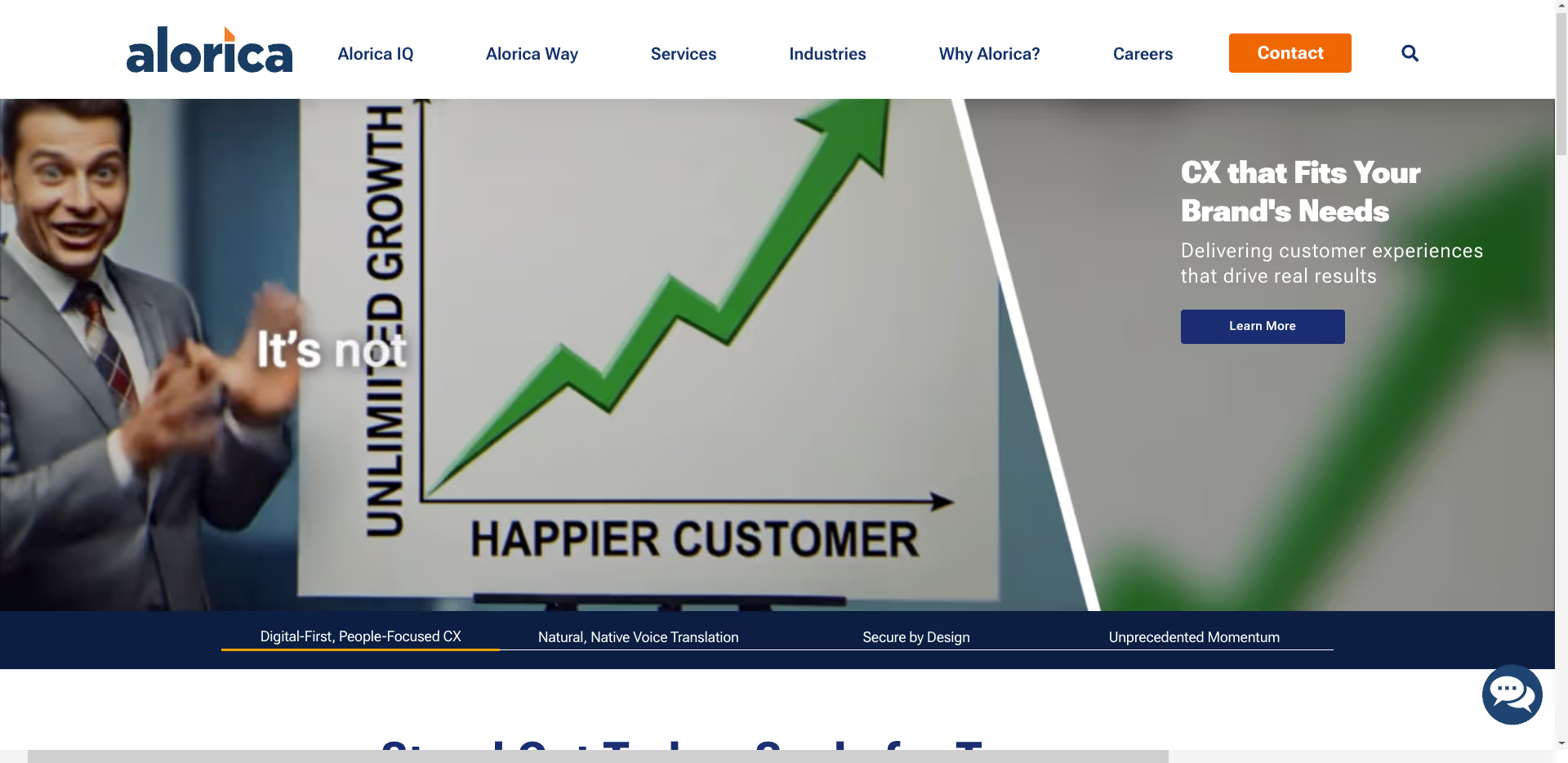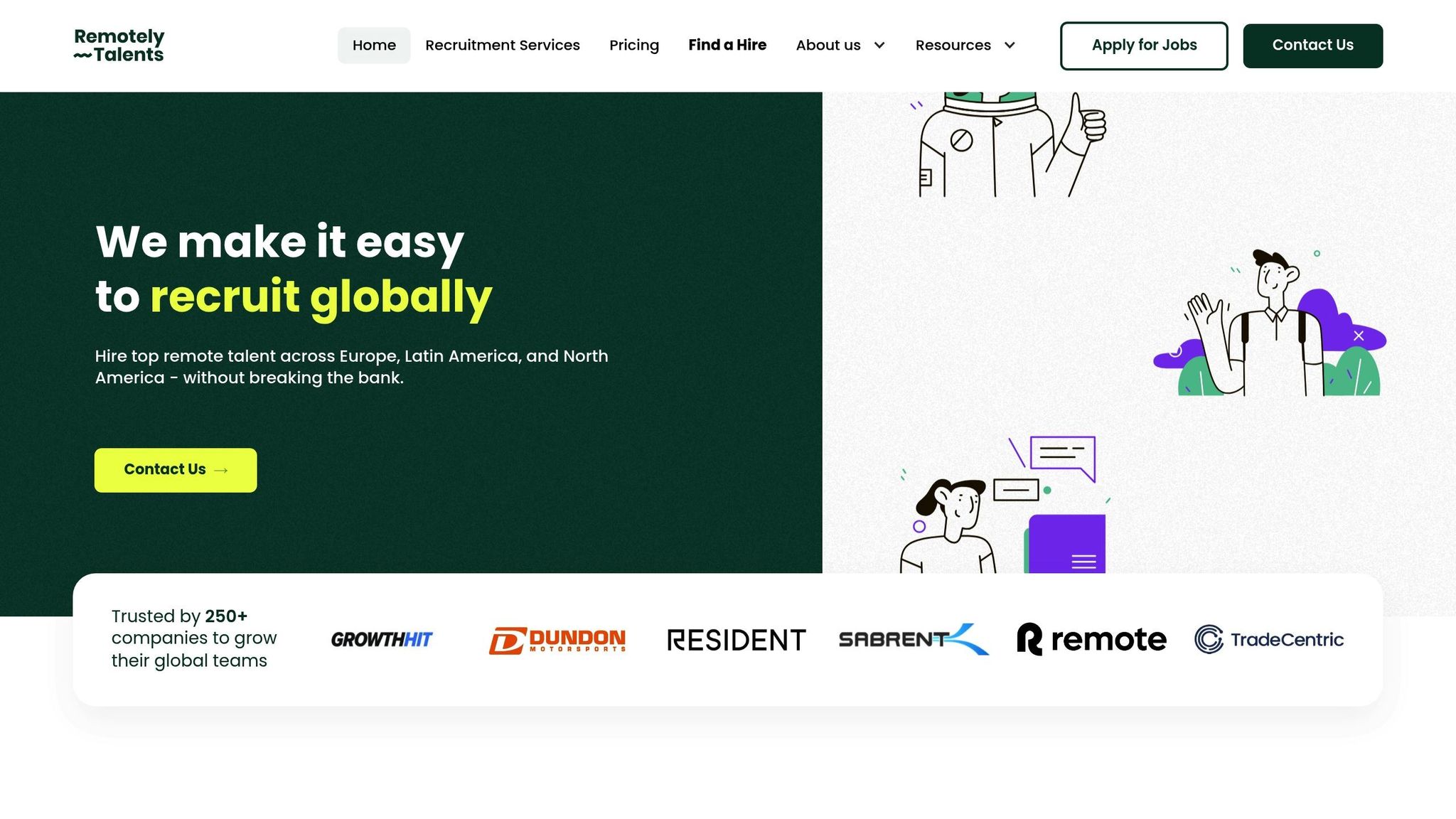Alorica Review 2026: A Deep Dive Into Features, Pricing, and Competitors

In 2026, businesses choosing between outsourcing and direct hiring have two standout options: Alorica and RemotelyTalents. Alorica offers a fully managed customer experience solution, ideal for large enterprises needing extensive services, while RemotelyTalents connects businesses with pre-vetted remote professionals for direct hiring, cutting costs by up to 70%.
- Alorica: A premium outsourcing provider handling recruitment, training, and technology. Its services cater to large-scale operations, offering multilingual support and enterprise-grade tools like ReVoLT. Pricing is customized but tends to be higher due to its managed service model.
- RemotelyTalents: A subscription-based platform for hiring remote professionals. Transparent pricing starts at $1,000/month, giving businesses full control over their teams and reducing costs significantly.
Quick Comparison
| Feature | Alorica | RemotelyTalents |
|---|---|---|
| Service Model | Fully managed outsourcing | Direct hiring |
| Pricing | Custom, enterprise-level | $1,000–$1,450/month |
| Control | Limited (third-party managed) | Full (direct team integration) |
| Scaling | Multi-year contracts required | Flexible, no long-term lock-in |
| Best For | Large enterprises | SMBs, startups |
Alorica suits enterprises needing end-to-end outsourcing, while RemotelyTalents appeals to smaller businesses seeking cost-effective, direct hiring solutions. Keep reading for a detailed breakdown of features, pricing, and user experiences.
Alorica Company Review | Honest Feedback by Employees | Cubao Site

1. Alorica
To get a clear picture of outsourcing efficiency in 2026, let’s start by looking at how Alorica operates as a managed service provider. Instead of hiring individual agents, businesses work with Alorica to manage entire customer experience teams. Alorica takes care of everything - recruiting, training, technology, and quality management. This all-in-one approach works well for large enterprises but can add extra costs that may not suit smaller businesses.
With delivery centers in over 15 countries, Alorica expanded its operations in India during Q3 2025, adding 1,500 jobs in Bangalore and Mohali [1]. This move shows Alorica’s ability to scale quickly for large clients, but it also reflects the kind of infrastructure investments that influence their pricing.
Cost Model and Pricing Structure
Alorica’s pricing follows a premium managed service model, with costs varying based on the complexity of services, the volume of work, and the delivery location. They don’t publish standard rates, as pricing depends on client-specific needs. However, industry insights suggest U.S.-based services are priced higher than offshore options. This difference reflects the expenses tied to management, technology platforms, training, and quality assurance.
"Great CX doesn't just happen – it's built on technology, customer insights, talented teams and time-tested processes." - Alorica [1]
Scaling Capabilities and Contract Terms
With over 25 years of experience in customer experience (CX) and significant growth in 2025, Alorica is well-equipped to handle scaling for enterprise clients [1]. Their contracts typically involve multi-year agreements with minimum volume commitments. While this provides cost stability for large businesses, it can be less flexible for companies needing to adjust team sizes frequently.
Alorica’s ReVoLT technology is another standout feature, offering real-time translation in over 75 languages. This advanced tool caters to global corporations, but for businesses with simpler needs, it might feel like paying for features they don’t require.
Client Experience and Service Delivery
Alorica’s managed service model has earned praise, especially from enterprise clients who value its end-to-end service delivery. A CX Leader from a Top 10 U.S. Bank shared:
"Launching our business with Alorica was an exceptionally smooth process. The team was highly efficient and supportive, making the entire setup effortless and seamless." [1]
However, this approach does have its trade-offs. Clients work through Alorica’s account managers rather than managing their customer service teams directly. While this hands-off model appeals to companies looking for simplicity, it may not suit businesses that prefer greater control over their teams.
Alorica positions itself as a CX partner rather than a vendor, emphasizing collaboration. As the company puts it:
"Brands need a CX partner who's their strategist, not just another vendor. We partner to drive growth and long-term brand loyalty by delivering today's solutions while planning for tomorrow's growth." [1]
While this partnership-driven approach benefits large-scale operations, it can also create a dependency that limits flexibility. Businesses might find themselves locked into higher long-term costs compared to building their own remote teams. Up next, we’ll look at RemotelyTalents’ direct hiring model as a leaner alternative to this layered setup.
2. RemotelyTalents

Unlike Alorica's managed service provider model, RemotelyTalents operates with a direct hiring approach. It connects businesses directly with remote professionals across regions like Europe, Latin America, and North America. By bypassing traditional outsourcing fees, it offers a transparent, performance-driven solution.
Subscription-Based Pricing Model
RemotelyTalents makes costs predictable with two simple subscription plans. The On-Demand Plan is $1,450 per month per role and allows for flexible cancellation. The Partner Plan, priced at $1,000 per month with a 12-month commitment, lets you make unlimited hires for one active project, with additional projects available at the same rate [2]. For companies hiring 4–6 roles annually, the Partner Plan can save over $5,400 compared to the On-Demand option.
Both plans include valuable features like a senior recruiter, account manager, Slack communication, weekly progress updates, and a 90-day replacement guarantee [2]. These offerings make RemotelyTalents a cost-efficient alternative to managed outsourcing.
Cost Efficiency and Direct Employment
With RemotelyTalents, businesses can cut staffing costs by as much as 50–70% through direct hiring [2]. The platform charges a flat recruitment fee, and you pay the employee's salary directly - there’s no markup or ongoing service fee after hiring. This straightforward approach ensures you get maximum value for your investment.
Flexibility and Team Ownership
Kay Tayam, CEO of 88 Affect, shared his experience working with RemotelyTalents:
"Remotely Talents provided an amazing 5 STAR service for our marketing company, if I could rate it 6 stars I would. I was able to find the candidate for our job with extreme ease. Their process is very optimized in terms of speed and expectations throughout the process. I've tried a lot of remote talent services before for our remote expansion as a US company, and they delivered an experience that was far superior in terms of speed, price, and most importantly transparency. If you're looking for a company to take the hard work off your plate, it doesn't get better than Remotely Talents." [2]
This model allows businesses to maintain full ownership of their teams. New hires seamlessly integrate into your company, follow your internal processes, and report directly to your managers - without a middleman managing daily tasks. This fosters better alignment with your company’s goals and culture.
Scalability Without Long-Term Lock-In
RemotelyTalents also provides flexibility for businesses that need to scale. The Partner Plan’s unlimited hiring structure is ideal for growing companies that frequently add team members. You can adjust staffing levels as needed without being tied to rigid volume requirements or lengthy contracts. With an average recruitment time of 4–6 weeks and the option to add extra active projects for $1,000 per month each, the platform is well-suited for companies handling multiple hiring initiatives [2].
For businesses looking to move away from traditional outsourcing, RemotelyTalents offers a cost-conscious solution with direct team ownership and professional recruitment support. It’s a practical choice for companies aiming to build remote teams efficiently and transparently.
sbb-itb-88a7fe6
Pros and Cons
Alorica and RemotelyTalents each bring unique strengths to the table, catering to different business needs. However, their contrasting models come with specific trade-offs that are worth considering.
Alorica's strengths lie in its large-scale infrastructure and established reputation with Fortune 500 companies. In the first half of 2025, the company achieved its highest-ranked performance, with most clients rating it No. 1 or No. 2 among their customer experience (CX) partners[4]. Their Agent Assist technology processed over 45 million notifications, delivering up to 20% productivity gains for clients[5]. Additionally, Alorica offers 24/7 multilingual support in 120+ languages through its evoAI platform, making it an excellent choice for businesses requiring large teams and global reach on short notice[6].
However, Alorica's limitations become evident in terms of cost and control. The managed service model often results in costs that are more than double the base pay due to management layers and corporate overhead. Furthermore, clients relinquish direct control over recruitment, training, and day-to-day management, which may not suit businesses seeking greater flexibility.
On the other hand, RemotelyTalents' advantages focus on cost transparency and direct team ownership. By enabling companies to hire remote professionals directly, it offers a way to build integrated teams while maintaining operational control. Clients frequently praise the platform for its speed, competitive pricing, and straightforward processes compared to traditional outsourcing models[3].
The downsides of RemotelyTalents include the need for businesses to handle their own management and compliance tasks. Companies must invest in HR systems, payroll, and management resources, as they are directly responsible for overseeing their remote teams.
| Feature | Alorica | RemotelyTalents |
|---|---|---|
| Value Proposition | Large-scale managed service | Cost-effective direct hiring |
| Control Level | Limited (third-party managed) | Full (direct team integration) |
| Cost Predictability | Variable (enterprise pricing) | Transparent (flat fee structure) |
| Management Investment | Minimal (outsourced) | Moderate (requires internal oversight) |
| Cultural Alignment | Indirect via account managers | Direct team integration |
| Ideal Business Type | Large enterprises, regulated sectors | SMBs, startups, remote-first teams |
Ultimately, the choice between these models depends on your business's goals, size, and priorities. Alorica stands out for companies needing fully managed, large-scale operations with minimal internal involvement. Meanwhile, RemotelyTalents is better suited for businesses that value cost efficiency, direct control, and the ability to shape their own team culture with remote professionals.
Conclusion
Choosing the right staffing solution depends on factors like company size, budget, and operational needs. Each platform caters to different market segments and offers unique approaches to tackling staffing challenges.
For large enterprises that need managed, high-volume customer experience operations, Alorica stands out. Its built-in compliance, 24/7 multilingual support, and extensive infrastructure make it a solid choice - though these features come with higher costs. This setup highlights the ongoing debate between traditional outsourcing and direct hiring.
On the other hand, small and medium businesses may gravitate toward RemotelyTalents. With its transparent pricing and ability to reduce staffing costs by 50–70%, it provides a cost-effective alternative. The platform also offers businesses full control over recruitment, training, and daily operations - a key advantage for companies that value direct oversight. As Kay Tayam, CEO of 88 Affect, shared:
"Delivered an experience that was far superior in terms of speed, price, and most importantly transparency" [2].
For decision-makers planning for 2026, critical considerations include:
- Whether a fully managed solution or direct team control better suits their needs
- Budget flexibility for enterprise-level pricing versus cost-conscious options
- The scale of operations and compliance requirements
Startups and SMBs will likely find RemotelyTalents better suited to their growth goals and budget constraints. The platform’s 90-day replacement guarantee and ability to deliver qualified candidates within two weeks address common concerns about speed and quality - factors that often push businesses toward pricier managed services [2]. Meanwhile, enterprises with large-scale customer experience needs and strict regulatory demands will continue to benefit from Alorica’s well-established infrastructure and expertise.
Ultimately, while managed services remain a reliable choice for some, direct hiring is proving to be an agile and adaptable solution for today’s evolving business landscape.
FAQs
What are the main differences between Alorica's outsourcing model and hiring directly?
Alorica uses a managed service outsourcing model, meaning they handle hiring, training, and managing staff for you. This setup is convenient for larger businesses that need scalability without the hassle of direct oversight. However, the added management layers can make it a pricier option.
On the other hand, direct hiring lets you build and manage your own team. This approach provides full control, more flexibility, and often leads to significant cost savings. It's a great choice for startups, SMBs, or businesses looking to stay hands-on while keeping expenses in check.
How does Alorica's pricing affect its suitability for different businesses?
Alorica customizes its pricing based on each client's specific needs, considering factors such as company size, required services, and location. Industry estimates suggest that U.S.-based support typically costs $25–$45 per hour, while offshore services range from $10–$20 per hour.
This pricing structure, which accounts for management and infrastructure expenses, is more suited to large enterprises handling high volumes. On the other hand, smaller businesses or startups might find it less budget-friendly due to the higher overhead costs and less transparent pricing.
What should businesses evaluate when choosing between outsourcing and directly managing their team?
When choosing between outsourcing and managing a team in-house, businesses need to weigh factors such as cost, control, and flexibility. Outsourcing, particularly fully managed solutions, tends to be more expensive because of added overhead costs. However, it offers convenience and the ability to scale operations quickly, making it a strong option for larger companies.
On the other hand, managing a team directly allows businesses to maintain greater control over training, workplace dynamics, and day-to-day operations. It also comes with the advantage of cutting costs by sidestepping third-party fees. This hands-on approach works well for companies that prioritize agility and transparency in how they manage their workforce.
Related Blog Posts
Read also
Ready to get started?
If you want to dive into the details just Book a Free Consultation with our staff and we’ll be happy to answer your questions.





